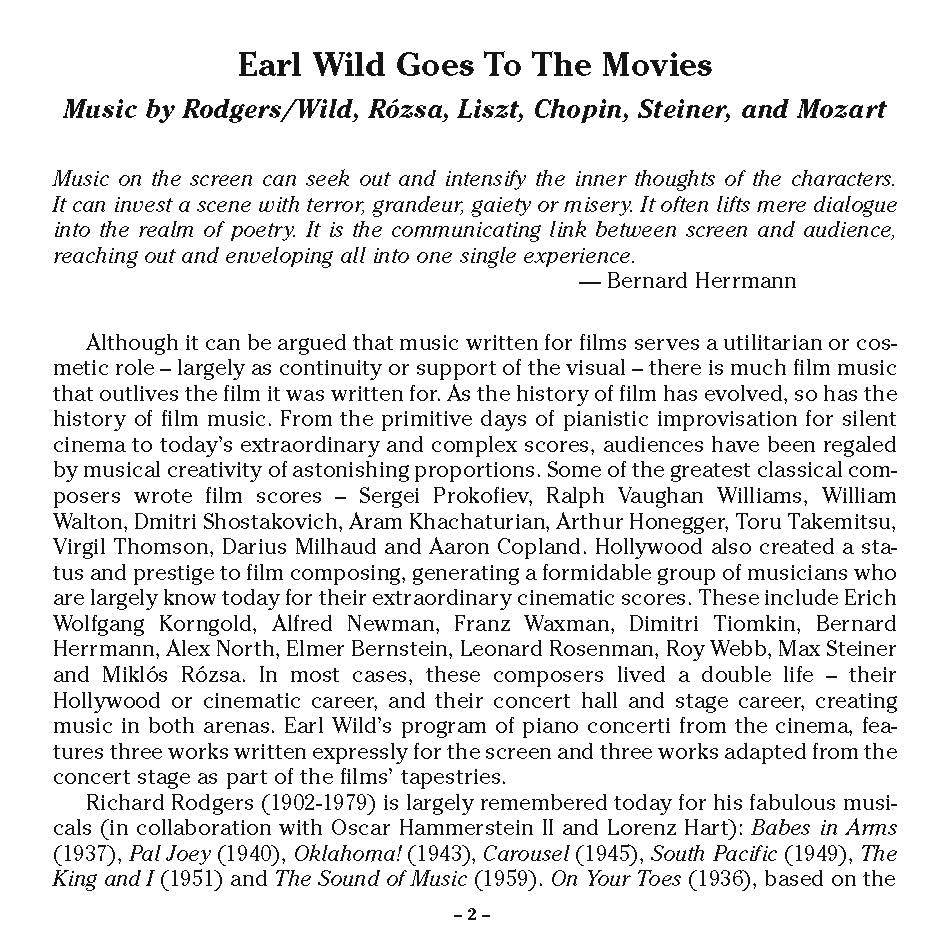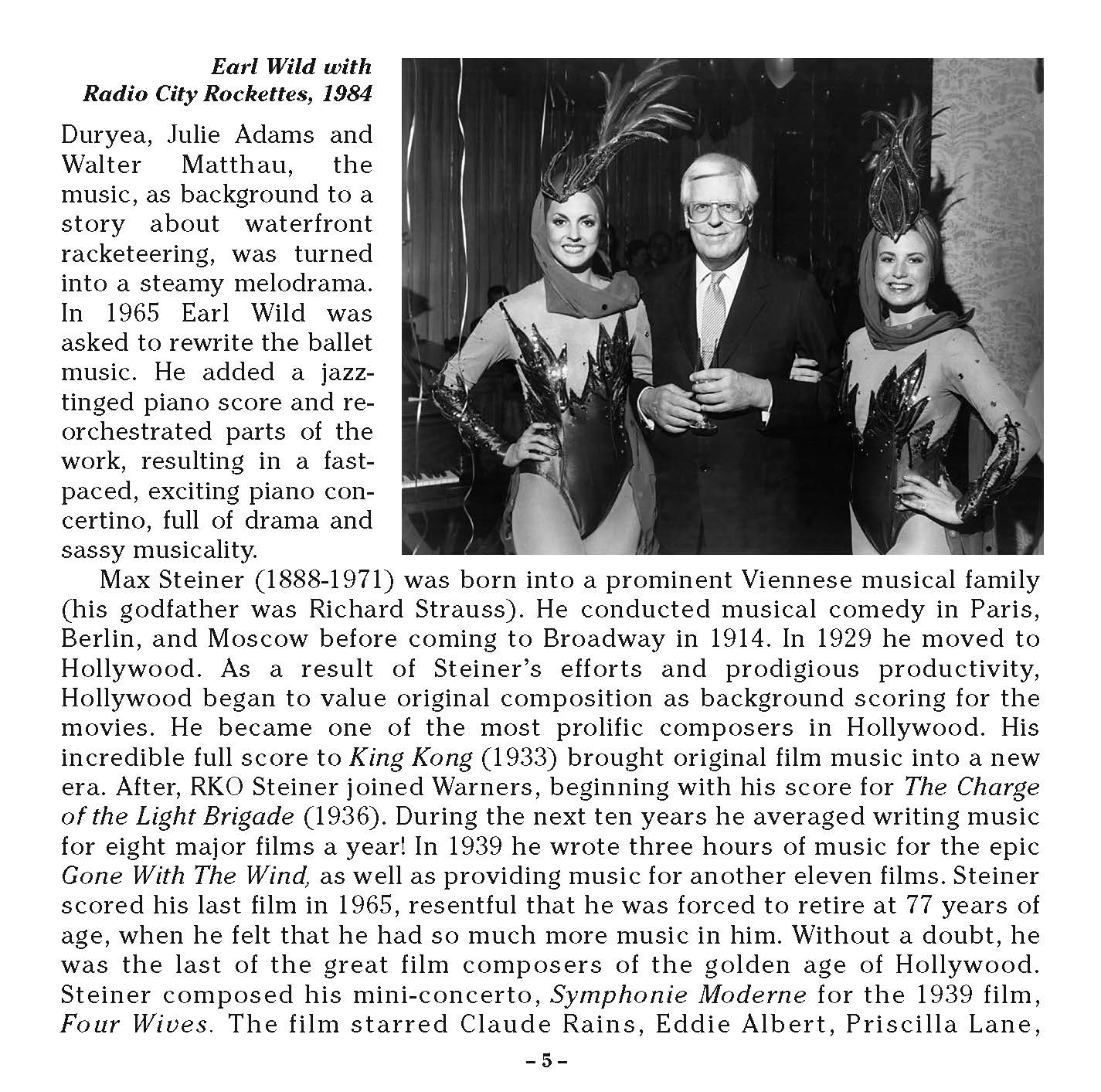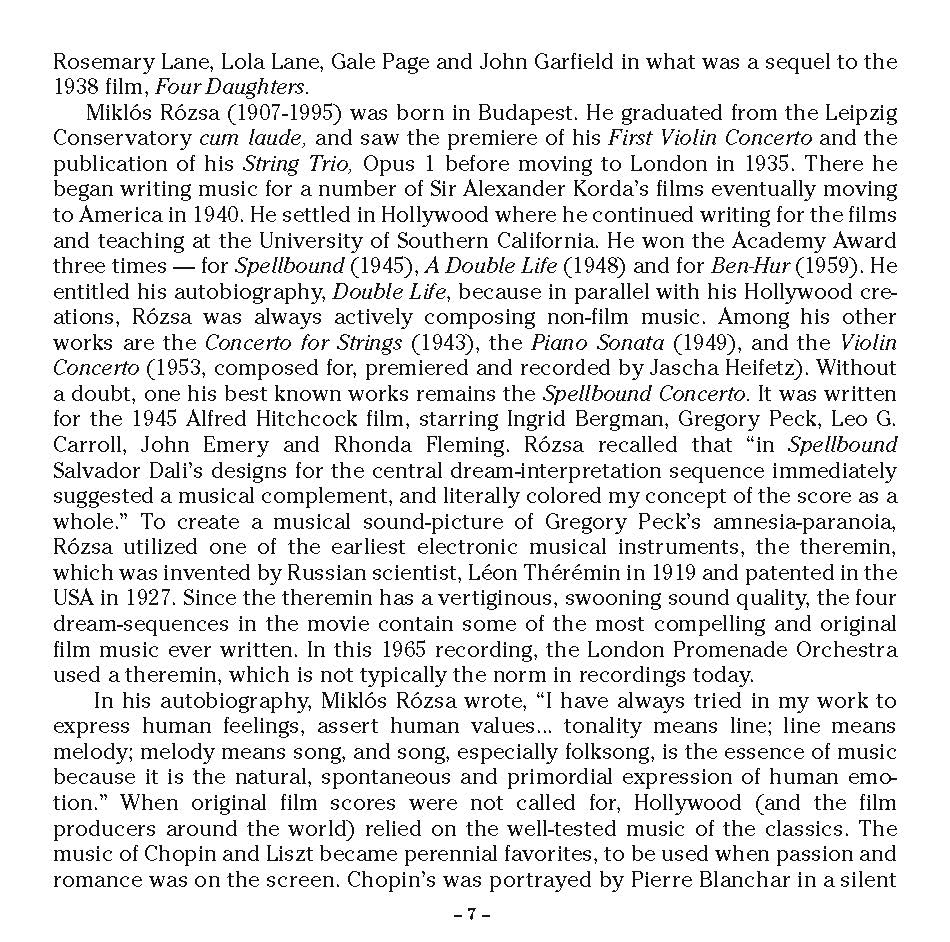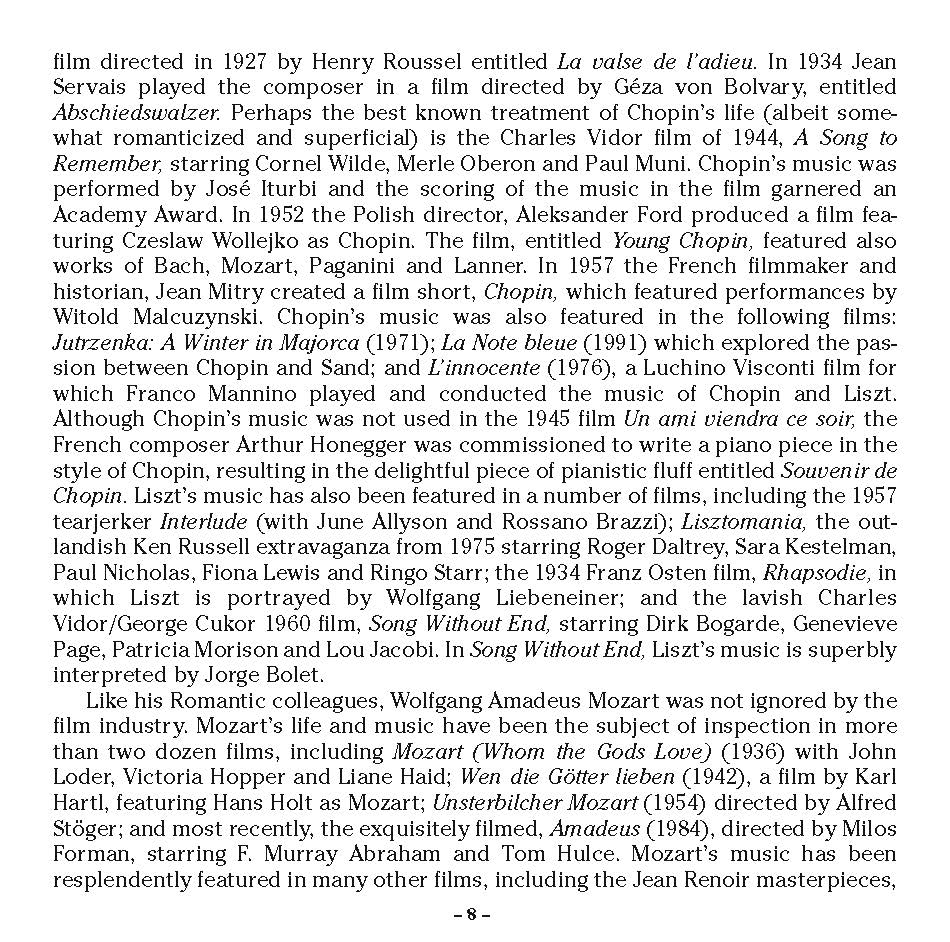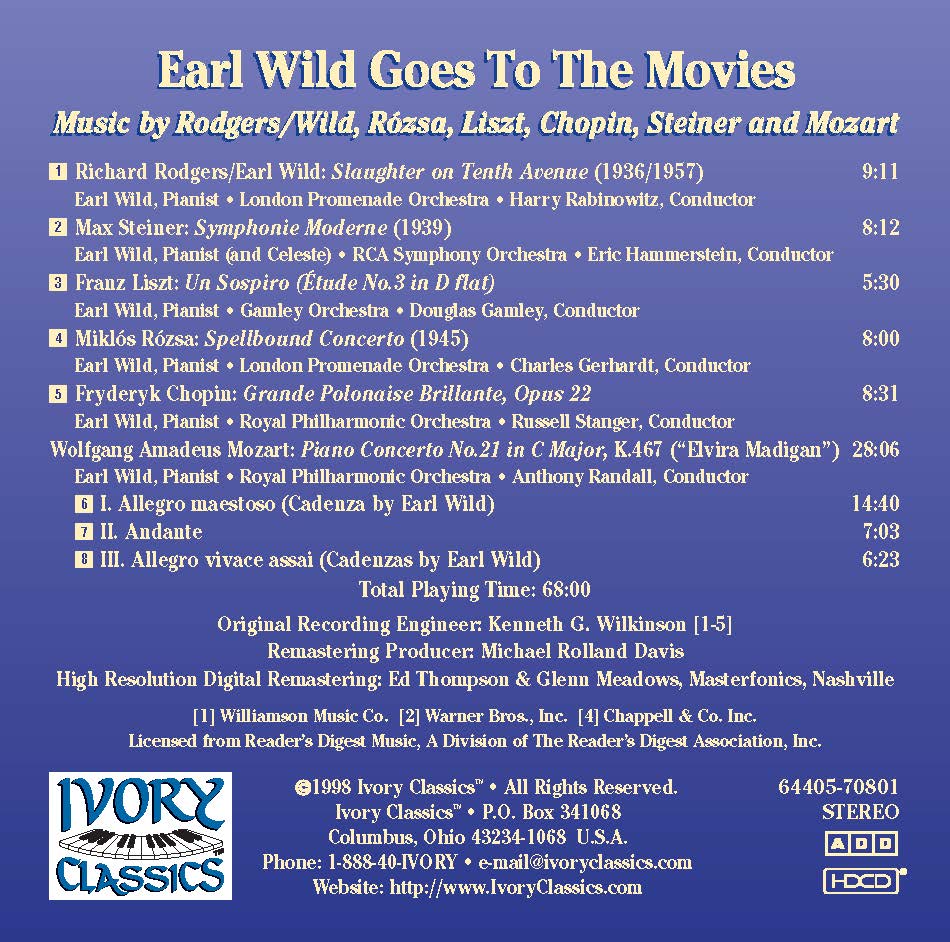Earl Wild Goes to the Movies - Piano & Orchestra works
Earl Wild Goes to the Movies - Piano & Orchestra works
Couldn't load pickup availability
Earl Wild Goes to the Movies features the original arrangements of 20th-century film music, performed by Earl Wild on the piano and conducted by Carl Davis and the Royal Philharmonic Orchestra. The tracks on the album include pieces from classic films such as An American in Paris, Casablanca, and Gone with the Wind. This unique collection of film music provides an authentic and detailed orchestral accompaniment to Earl Wild's masterful piano performance.
Ivory Classics CD-70801
Earl Wild Goes to the Movies
Richard Rodgers / Earl Wild
Producer: Michael Rolland Davis
Engineer: Ed Thompson
Piano: Steinway
Mastered using 20-Bit State-of-the-Art Technology - HDCD Encoded
Classic concertos for piano and orchestra.
Disc.Reviews
Earl Wild is a major American musician. As pianist, he has played with distinction under the batons of many famous conductors including Toscanini and Klemperer. Rachmaninov was his friend and important idol in his life – indeed, Wild's recordings of Rachmaninov have always been admired. This American recording was made last year and the booklet remarked that Earl was then 82 years old but still planning new recordings. Besides being a virtuoso pianist Earl Wild, has also been busy as composer, transcriber, conductor, editor, and teacher.
Earl Wild also made a number of recordings of film music for the Readers Digest Association. Some were released by RCA as part of the Charles Gerhardt Classic Film Scores series. All the recordings on this album were made in London, all engineered by Kenneth Wilkinson. They have been remastered in high-resolution digital sound and, for the most part, they sound fabulous.
Richard Rogers - Slaughter on 10th Avenue. Richard Rodgers is remembered chiefly for hit shows (with Oscar Hammerstein II) like Oklahoma! (1943); Carousel (1945); South Pacific (1949), The King and I (1951); and The Sound of Music (1959) all of which have been filmed, of course. 'Slaughter on 10th Avenue' originated as a ballet, choreographed by the great George Balanchine for the 1936 musical On Your Toes. The ballet, in a rather comical mode, was included in the 1939 film version of the musical (starring Eddie Albert, Vera Zorina and Donald O'Connor). The ballet assumed a darker, steamier air for the 1957 film entitled Slaughter on 10th Avenue (with Richard Egan, Jan Sterling, Dan Duryea, Julie Adams and Walter Matthau). Then, in 1965, Earl Wild rewrote the ballet music adding a jazz-tinged piano score. He also re-orchestrated parts of it so that it became this fast-paced, exciting piano concertino. I must tell you that although you might hear many performances of 'Slaughter on 10th Avenue' in a lifetime, none, but none of them could compare to this sassy, thrilling reading.
Max Steiner – Symphonique Moderne. Steiner composed this mini-concerto for the 1939 film, Four Wives (the sequel to the successful 1938 film Four Daughters) starring Claude Rains, the Lane sisters (Priscilla, Rosemary and Lola) and John Garfield as a struggling young musician. 'Symphonie Moderne' was expanded by Charles Gerhardt who played it for Max Steiner shortly before his death. It is written in the grand late Romantic tradition but with the injection of modern American 'urban' influences.
Franz Lizst – Un Sospiro (Étude No. 3 in D flat). Lizst's music has been used in many films especially in the many screen biographies of the composer. This is a very attractive little piece played with panache by Wild and Douglas Gamley and his orchestra.
Miklós Rózsa – Spellbound Concerto. This popular concerto with its magnificent sweeping romantic melody, was composed from Ròzsa's music for one of Alfred Hitchcock's early psychosis-based thrillers. Gregory Peck, in the film, Spellbound, is the amnesia/paranoia patient whose illness and disturbed dream world (photographed against Salvatore Dali's surreal designs) is vividly portayed by Ròzsa brilliantly using the theremin, an early electronic musical instrument.
Chopin – Grande Polonaise Brillante Op. 22. Like Lizst, Chopin's brilliant virtuosity and colourful life was ripe for screen biography treatment. Both composers' music was also in great demand when passion and romance was on the screen.
Mozart – Piano Concerto in C Major, K 467 ("Elvira Madigan"). This is the major work on the programme and is performed in its 28-minute entirety. It is a sparkling work and the Andante was used to great effect in the Swedish film Elvira Madigan. Wild gives a beautifully controlled and sensitive performance.
The 12-page booklet which accompanies this album, carries full notes about the music and the films, together with some remarkable photographs including one of a line-up of eleven composers attending a Hollywood Bowl dinner in July 1948 including: George Antheil, Miklós Rózsa, William Grant Still, Igor Stravinsky and Erich Wolfgang Korngold. A collectable anthology
Ian Lace, MusicWeb International, Nov. 1999
This new label focuses on 'The Art of the Piano' and 'The Art of the Pianist.' They will be reissuing fine performances from the past, many never before issued on CD, from both known and unjustly-neglected pianists. All material on this disc was recorded in the 60's (except the Mozart 'Concerto' which was recorded in 1982) for Reader's Digest Records, produced by Charles Gerhardt and engineered by the legendary Kenneth Wilkinson. These pieces have been perfectly transferred to silver disc and sound better than ever. Just listen to the opening piece - Mr. Wild's inventive arrangement of Richard Rodgers' 'Slaughter on Tenth Avenue,' for a sample of the wide-range, dazzling sonic quality to be heard throughout. Especially in the 'Spellbound Concerto' and 'Symphonie Moderne' the 'Big Cinema Sound' is always apparent. Wild is as stylish in Mozart as he is in film music; this is a fine performance of polish and character.
Classic CD, Dec. 1998
In a market increasingly infected by easy compilations and cheap crossover albums, this release serves as a welcome antidote - a model for how to offer lightness of spirit without sacrificing artistic quality. The performances are vintage Wild. Earl Wild is so responsive to the idioms of each work that it’s sometimes hard to believe that we’re listening to a single pianist. The sound outclasses that on most releases being produced today.
Fanfare Magazine, Oct. 1998
Wild's Mozart 'Concerto No. 21' has been a favorite of mine from its vinyl days - so beautifully phrased and impeccably played that it never fails to win me over. Rodgers' 'Slaughter on 10th Avenue,' is an effulgent, spectacular piano concerto arrangement by Wild. Two thumbs up.
American Record Guide, Aug. 1998

